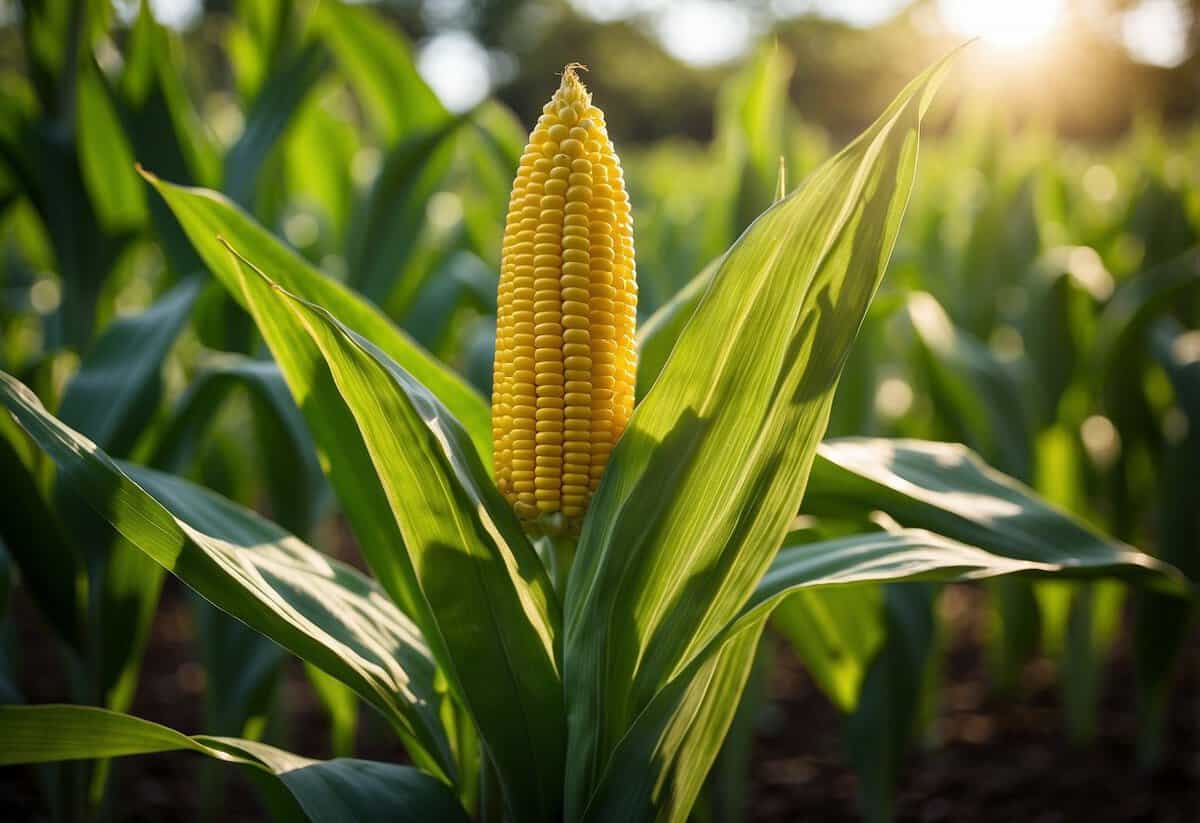Tips for Growing Sweet Corn in the Garden: A Gardener’s Guide
Growing sweet corn in your garden can be a rewarding experience. Whether you’re a seasoned gardener or a beginner, getting started with sweet corn can be a fun project that yields delicious results. Learning some basic tips can help ensure a bountiful harvest of juicy, sweet ears.

Sweet corn is a staple of many summer gardens. With the right care and attention, you can enjoy fresh corn straight from your garden. In this article, we’ll cover some essential tips you need to know to grow sweet corn successfully.
1) Choose the Right Variety

Picking the right variety of sweet corn for your garden can make a huge difference. Some varieties like the Nirvana hybrid are known for their sweetness.
Other popular options include Golden Bantam, which is famous in the United States for its rich yellow kernels.
Make sure to choose a variety that fits your taste preferences and growing conditions. This can help you get the best results from your garden.
2) Plant in Full Sun

Your corn plants need full sun to thrive. Aim for at least 6 to 8 hours of direct sunlight every day. This will help the plants grow strong and healthy.
Full sun ensures that your corn gets enough energy for photosynthesis. This leads to better growth and larger harvests.
3) Prepare the Soil

To grow sweet corn, start by choosing a sunny spot in your garden. Corn needs well-drained soil with plenty of organic matter.
Before planting, add aged compost to the soil. This will provide the nutrients your corn needs to grow tall and strong.
Using a garden fork or tiller, loosen the soil to a depth of about 6 inches. This helps the roots establish themselves easily. Dust the area with a nitrogen-rich meal, such as cottonseed or soybean meal, to boost growth.
By taking these steps, you’re setting up your corn for a successful growing season.
4) Space Seeds Properly

For healthy sweet corn, it’s important to space your seeds correctly.
Plant seeds about 1 inch deep and 7-9 inches apart. This gives each plant enough room to grow.
Keep rows 24-30 inches apart for better air circulation and easier access.
Planting in blocks rather than single rows helps ensure good pollination and better yields.
5) Water Consistently

Your sweet corn will need a lot of water to grow strong and healthy. Aim to provide about 1-2 inches of water per week.
It’s best to water deeply and less frequently rather than shallow watering. This encourages deeper root growth.
Try to keep the soil consistently moist, but make sure it is well-drained. Overwatering can cause problems too.
6) Add Mulch

Adding mulch is a great way to help your sweet corn grow strong. It keeps the soil moist and prevents weeds from taking over.
Spread a layer of organic mulch, like straw or grass clippings, around your corn plants. This will also help to regulate the soil temperature.
Remember to keep the mulch a few inches away from the stalks to avoid any rot. Mulching is simple but very effective!
7) Fertilize Regularly

Giving your sweet corn the right nutrients is key to healthy growth. You should use a balanced fertilizer, such as 10-10-10, at planting time. This helps the seeds get off to a strong start.
As the corn continues growing, it’s important to apply fertilizer again. Using a side dressing technique works best. Spread the granular fertilizer about 3 inches away from the main stalk. Regular feeding ensures your corn gets the nutrients it needs, resulting in bigger, sweeter cobs. For detailed guidelines, you can refer to this fertilizing sweet corn guide.
8) Watch for Pests

When growing sweet corn, it’s important to stay vigilant for common pests. Insects like the corn earworm, aphids, and cutworms can cause significant damage to your crop.
Check your corn daily for any signs of these pests. If you spot them early, you can manage them before they get out of hand.
Look for damage on leaves and ears. If you notice anything unusual, consider using organic pesticides or natural predators to keep these pests under control. Regular monitoring will help ensure a healthy, bountiful harvest.
For more information, visit this guide on pest management.
9) Rotate Crops

Rotating crops is essential for sweet corn. If you plant corn in the same spot every year, soil nutrients can become depleted.
By rotating crops, you reduce the chances of pests and diseases building up in the soil. This practice keeps your garden healthier.
Corn benefits from being rotated with light feeders. It’s easy and makes a big difference.
For more about crop rotation, read here.
10) Support Tall Stalks

Tall corn stalks can topple over from wind or heavy rain. You can support them by building simple structures. For example, you can use stakes and string to keep the stalks upright.
Another method is to plant your corn in blocks rather than rows. This allows the stalks to support each other, reducing the risk of falling. You can learn more about keeping your corn stalks standing here.
Choosing the Right Variety

Selecting the right variety of sweet corn is crucial for a successful harvest. Consider the sweetness, maturity time, and your local climate to choose the best types for your garden.
Best Sweet Corn Varieties for Home Gardens
There are several sweet corn varieties that are well-suited for home gardens. ‘Nirvana’ and ‘Golden Bantam’ are popular choices. The ‘Nirvana’ hybrid is known for its high sugar content, making it one of the sweetest options available. ‘Golden Bantam’ is a classic variety that made yellow sweet corn famous in the United States.
Another excellent choice is the ‘Kickoff XR’ variety, which combines sweetness with a good balance of flavors. It’s perfect for those who prefer a mix of textures and tastes. When selecting your variety, also consider the days to maturity. Varieties like ‘Golden Bantam’ take around 80 days to mature, giving you a clear timeline for your gardening plan.
Climate Considerations
Your local climate plays a significant role in choosing the best sweet corn variety. If you live in a region with a shorter growing season, opt for varieties that mature quickly. For instance, ‘Golden Bantam’ and ‘Kickoff XR’ mature within 70-80 days, making them suitable for cooler climates or areas with early frosts.
In warmer climates with longer growing seasons, you can choose varieties that take longer to mature. These may offer unique flavors and larger ears. Make sure the variety you choose can thrive in your specific weather conditions. For example, sweet corn varieties with a higher water requirement will need consistent watering in dryer climates to ensure healthy growth and sweet kernels.
Planting Sweet Corn

Planting sweet corn involves preparing the soil properly and using the right planting techniques to ensure a healthy crop. You’ll need to pay attention to soil conditions and spacing to set your corn up for success.
Soil Preparation
Before you plant sweet corn, it’s important to prepare the soil thoroughly.
First, choose a spot in your garden that gets full sun. Corn needs a lot of sunlight to grow well.
Next, ensure that the soil is well-draining and rich in organic matter. You can improve soil quality by adding compost or aged manure. This will provide the nutrients your corn needs.
Loosen the soil using a garden fork or tiller to a depth of at least 6-8 inches. This helps roots grow deep and access vital nutrients.
Check the soil’s pH level. Sweet corn grows best in slightly acidic to neutral soil with a pH between 6.0 and 7.0. You can adjust the pH with lime if it’s too acidic or sulfur if it’s too alkaline.
Planting Techniques
When it comes to planting sweet corn, timing and spacing are key.
Plant your corn seeds directly outdoors about two weeks after the last frost when the soil has warmed up to at least 60°F (15°C).
Sow the seeds 1/2 inch deep in cool, moist soil. In warmer, dry soil, plant them 1 to 1 1/2 inches deep to retain moisture.
Space the seeds about 4-6 inches apart within the row. This ensures each plant has enough room to grow without competing for resources.
Rows should be spaced 30-36 inches apart to prevent cross-pollination, especially if you’re planting different corn varieties.
Once the seedlings are about 3-5 inches tall, thin them out so that they are spaced 12 inches apart. This helps each plant get enough light and nutrients.
Keep the soil consistently moist, providing about 1-2 inches of water per week.
For more detailed information, you can check out this guide to growing sweet corn.
Caring for Your Crop

To get the best sweet corn, you need to provide consistent care. This includes ensuring proper watering and fertilization throughout the growing season.
Watering Schedule
Sweet corn needs plenty of water to thrive. Make sure your corn gets at least 1 inch of water per week. During hot or dry spells, you might need to increase this to 2 inches.
Water deeply and less frequently to encourage strong root development. Shallow watering can lead to weaker roots. Use a soaker hose or drip irrigation to deliver water directly to the soil, minimizing evaporation.
Check the soil moisture by sticking your finger about 1 inch deep into the soil. If it feels dry, it’s time to water.
Fertilization Tips
Sweet corn is a heavy feeder, which means it loves nutrients and regular fertilization. At planting time, use a 10-10-10 fertilizer to give your corn a strong start. This helps with rapid growth.
Side-dress your corn (apply fertilizer along the rows) when the plants are about knee-high, and again when they start to tassel. Use a balanced fertilizer or compost to boost nutrients.
Organic options, like Jobe’s Organics Purpose Granular Fertilizer, can also improve soil health. Always follow the fertilizer package instructions to avoid over-fertilizing. Over-fertilizing can lead to poor growth and environmental harm.
By maintaining a proper watering schedule and regularly fertilizing, your sweet corn will grow strong and produce delicious ears.







